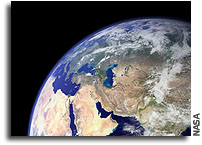Detectability of Planetary Characteristics in Disk-Averaged Spectra II: Synthetic Spectra and Light-Curves of Earth

Dec 2006, Vol. 6, No. 6 : 881 -900
Spatially and spectrally resolved models were used to explore the observational sensitivity to changes in atmospheric and surface properties and the detectability of surface biosignatures in the globally averaged spectra and light-curves of the Earth. Compared with previous efforts to characterize the Earth using disk-averaged models, a more comprehensive and realistic treatment of the surface and atmosphere was taken into account here.
Our results are presented as a function of viewing geometry and phases at both visible/near-infrared (0.5–1.7 µm) and mid-infrared (5–25 µm) wavelength ranges, applicable to the proposed NASA-Terrestrial Planet Finder visible coronagraph and mid-infrared interferometer and to the ESADarwin mission architectures. Clouds can change the thermal emission by as much as 50% compared with the cloud-free case and increase the visible albedo by up to 500% for completely overcast cases at the dichotomy phase. Depending on the observed phase and their distribution and type, clouds can also significantly alter the spectral shape. Moreover, clouds impact the detectability of surface biosignatures in the visible wavelength range. Modeling the disk-averaged sensitivity to the “red-edge,” a distinctive spectral signature of vegetation, showed that Earth’s land vegetation could be seen in disk-averaged spectra, even with cloud cover, when the signal was averaged over the daily time scale.
We found that vegetation is more readily discriminated from clouds at dichotomy (50% illumination) rather than at full phase. The detectability of phytoplankton was also explored, but was found to be more difficult to detect in the disk-average than land vegetation.
About Astrobiology and The Astrobiology Web
Astrobiology is the leading peer-reviewed journal in its field. To promote this developing field, the Journal has teamed up with The Astrobiology Web to highlight one outstanding paper per issue of Astrobiology. This paper is available free online at www.liebertpub.com/ast and to visitors of The Astrobiology Web at www.astrobiology.com.
Astrobiology is published quarterly in print and online. The journal provides a forum for scientists seeking to advance our understanding of life?s origins, evolution, distribution and destiny in the universe. A complete table of contents and a full text for this issue may be viewed online at www.liebertpub.com/ast.
Mary Ann Liebert, Inc., is a privately held, fully integrated media company known for establishing authoritative peer-reviewed journals in many promising areas of science and biomedical research. Its biotechnology trade magazine, Genetic Engineering News (GEN), was the first in its field and is today the industry?s most widely read publication worldwide. A complete list of the firm?s 60 journals, books, and newsmagazines is available at www.liebertpub.com
Mary Ann Liebert, Inc. – 140 Huguenot St., New Rochelle, NY 10801-5215 – www.liebertpub.com – Phone: (914) 740-2100 – (800) M-LIEBERT – Fax: (914) 740-2101








